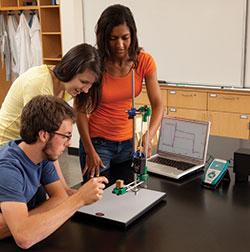If you have ever wanted to introduce your students to the study of human biomechanics, we have found a great product for you. While attending the Annual Meeting of the Human Anatomy and Physiology Society (HAPS), we came across two excellent interactive models that use Vernier sensors and our LabQuest to study human biomechanics.

The company, Denoyer-Geppert, in collaboration with Daniel Lemon and Joe Griswold from the City College of New York, developed fully articulated models of the human arm and leg and a complete set of laboratory exercises. Each model comes with a complete curriculum that incorporates a Vernier Dual-Range Force Sensor and a LabQuest to investigate the forces that are applied to the biceps tendon or Achilles tendon under varying loads and conditions. Our staff scientist, John Melville, has been working with each model, and has also found a way to measure joint angle using our Low-g Accelerometer. A picture of students using the human arm model to measure joint forces and angles with our Logger Pro software.
You can purchase the models from Denoyer. Go to “view products” and choose “human anatomy models”, then select “biomechanics” to see the models.
Don’t forget that you will need a LabQuest and a Dual-Range Force Sensor. If you want to measure joint angle, you will also need to purchase a Low-g Accelerometer. If you have any questions about these models, or any of our Human Physiology with Vernier exercises, contact John Melville.
